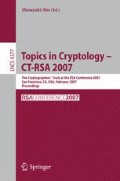Abstract
A digital signature scheme that achieves an optimal bandwidth (generating signatures as short as possible) is called an optimal signature scheme. The previous optimal signature schemes all need the random permutations (or the ideal ciphers) with large block size as building blocks. However, the practical cipher with large block size such as Halevi and Rogaway’s CMC-mode should call the underlying secure block cipher with small block size many times each time. This makes the previous optimal signature schemes which use the large domain permutation (or the ideal cipher) less efficient in the real world, even if there exist the methods that can encipher the messages with larger domain. On the other hand, all the practical signature schemes are not optimal in bandwidth including PSS-R, FDH, DSA, etc. Hence, the problem on how to design a practical, efficient and optimal signature scheme remains open.
This paper uses two random oracles and an ideal cipher with a smaller block size to design an optimal padding for signature schemes. The ideal cipher in our scheme can be implemented with a truly real block cipher (e.g. AES). Therefore, we provide a perfect solution to the open problem. More precisely, we design a practical, efficient and optimal signature scheme. Particularly, in the case of RSA, the padding leads the signature scheme to achieve not only optimality in bandwidth but also a tight security.
Access this chapter
Tax calculation will be finalised at checkout
Purchases are for personal use only
Preview
Unable to display preview. Download preview PDF.
References
An, J.H., Dodis, Y., Rabin, T.: On the security of joint signature and encryption. In: Knudsen, L.R. (ed.) EUROCRYPT 2002. LNCS, vol. 2332, pp. 83–107. Springer, Heidelberg (2002)
Bellare, M., Rogaway, P.: Random oracles are practical: a paradigm for designing efficient protocols. In: Proceedings of the 1st ACM conference on Computer and communications Security, pp. 62–73. ACM Press, New York (1993)
Bellare, M., Rogaway, P.: The exact security of digital signatures –how to sign with RSA and Rabin. In: Maurer, U.M. (ed.) EUROCRYPT 1996. LNCS, vol. 1070, pp. 399–416. Springer, Heidelberg (1996)
Chevallier-Mames, B., Phan, D.H., Pointcheval, D.: Optimal Asymmetric Encryption and Signature Paddings. In: Ioannidis, J., Keromytis, A.D., Yung, M. (eds.) ACNS 2005. LNCS, vol. 3531, pp. 254–268. Springer, Heidelberg (2005)
Boneh, D., Lynn, B., Shacham, H.: Short signatures from the Weil pairing. In: Boyd, C. (ed.) ASIACRYPT 2001. LNCS, vol. 2248, pp. 514–532. Springer, Heidelberg (2001)
Boneh, D., Boyen, X.: Short signatures without random oracles. In: Cachin, C., Camenisch, J.L. (eds.) EUROCRYPT 2004. LNCS, vol. 3027, pp. 56–73. Springer, Heidelberg (2004)
Canetti, R., Goldreich, O., Halevi, S.: The random oracle methodology, revisited. In: Proceedings of 30th Annual ACM Symposium on Theory of Computing (STOC), pp. 209–218. ACM press, New York (1998)
Coron, J.S.: On the exact security of full domain hash. In: Bellare, M. (ed.) CRYPTO 2000. LNCS, vol. 1880, pp. 229–235. Springer, Heidelberg (2000)
Coron, J.S.: Optimal Security Proofs for PSS and Other Signature Schemes. In: Knudsen, L.R. (ed.) EUROCRYPT 2002. LNCS, vol. 2332, pp. 272–287. Springer, Heidelberg (2002)
Dodis, Y., Reyzin, L.: On the Power of Claw-Free Permutations. In: Cimato, S., Galdi, C., Persiano, G. (eds.) SCN 2002. LNCS, vol. 2576, pp. 55–73. Springer, Heidelberg (2003)
Goh, E.J., Jarecki, S.: A signature scheme as secure as the Diffie-Hellman problem. In: Biham, E. (ed.) EUROCRYPT 2003. LNCS, vol. 2656, pp. 401–415. Springer, Heidelberg (2003)
Goldwasser, S., Micali, S., Rivest, R.: A digital signature scheme secure against adaptive chosen-message attacks. SIAM Journal of Computing 17(2), 281–308 (1988)
Granboulan, L.: Short signatures in the random oracle model. In: Zheng, Y. (ed.) ASIACRYPT 2002. LNCS, vol. 2501, pp. 364–378. Springer, Heidelberg (2002)
Halevi, S., Rogaway, P.: A Tweakable Enciphering Mode. In: Boneh, D. (ed.) CRYPTO 2003. LNCS, vol. 2729, pp. 482–499. Springer, Heidelberg (2003)
Lenstra, A., Verheul, E.: Selecting Cryptographic Key Sizes. In: Imai, H., Zheng, Y. (eds.) PKC 2000. LNCS, vol. 1751, pp. 446–465. Springer, Heidelberg (2000)
NESSIE consortium: NESSIE Security report. Deliverable Type Report D21, NESSIE (2002), Available from: http://www.cosic.esat.kuleuven.ac.be/nessie/index.html
Katz, J., Wang, N.: Efficiency improvements for signature schemes with tight security reductions. In: Proceedings of the 10th ACM conference on Computer and communication security, pp. 155–164. ACM Press, New York (2003)
Koblitz, N., Menezes, A.: Another look at “provable security”. Cryptology ePrint Archive, Report 2004/152 (2004), Available from: http://www.cacr.math.uwaterloo.ca/~ajmeneze/publications/provable.pdf
Libert, B., Quisquater, J.J.: The Exact Security of an Identity Based Signature and its Applications. Cryptology ePrint Archive, Report 2004/102, Available from: http://eprint.iacr.org/
Pointcheval, D., Stern, J.: Security proofs for signature schemes. In: Maurer, U.M. (ed.) EUROCRYPT 1996. LNCS, vol. 1070, pp. 387–398. Springer, Heidelberg (1996)
Pintsov, L., Vanstone, S.: Postal revenue collection in the digital age. In: Frankel, Y. (ed.) FC 2000. LNCS, vol. 1962, pp. 105–120. Springer, Heidelberg (2001)
Rivest, R.L., Shamir, A., Adleman, L.M.: A method for obtaining digital signatures and public-key cryptosystems. Communications of the ACM 21(2), 120–126 (1978)
Author information
Authors and Affiliations
Editor information
Editors and Affiliations
Rights and permissions
Copyright information
© 2006 Springer-Verlag Berlin Heidelberg
About this paper
Cite this paper
Qian, H., Li, Z., Chen, Z., Yang, S. (2006). A Practical Optimal Padding for Signature Schemes. In: Abe, M. (eds) Topics in Cryptology – CT-RSA 2007. CT-RSA 2007. Lecture Notes in Computer Science, vol 4377. Springer, Berlin, Heidelberg. https://doi.org/10.1007/11967668_8
Download citation
DOI: https://doi.org/10.1007/11967668_8
Publisher Name: Springer, Berlin, Heidelberg
Print ISBN: 978-3-540-69327-7
Online ISBN: 978-3-540-69328-4
eBook Packages: Computer ScienceComputer Science (R0)

